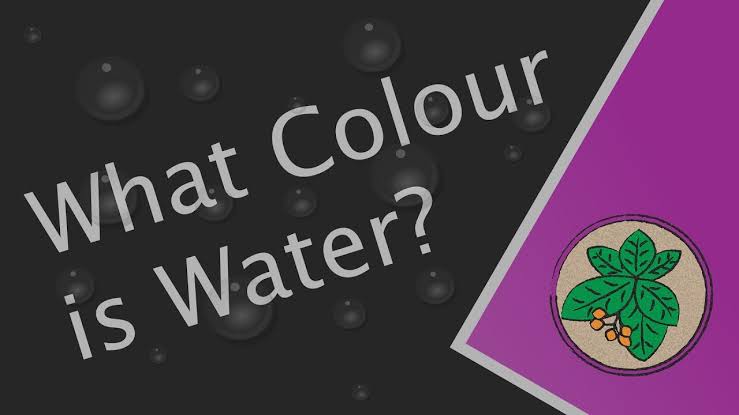| Posted on
Water itself is colorless. The variety we see in waterways, whether it's a reasonable mountain stream, a turquoise tropical sea, or a cloudy lake, is impacted by different elements, including the presence of pollution, suspended particles, and the impression of light.
1. Pure Water:
In its most perfect structure, water is straightforward and dull. This is because water atoms don't retain light in the visible part of the electromagnetic range. At the point when light goes through water, it isn't fundamentally modified, and the water shows up clear.
2. Absorption and Dissipation:
While water itself doesn't assimilate apparent light, it can retain and dissipate light in bright (UV) and infrared areas. Be that as it may, these impacts are not apparent to the natural eye. The retention of light by water is more perceptible at longer frequencies, for example, infrared, which is the reason water can retain heat from daylight.
3. Impurities and disintegrated substances:
Normal water bodies frequently contain pollutants and broken-up substances that can give water its trademark tone. For instance:
- Blue:
Waterways frequently seem blue because of the specific retention of longer frequencies of light (red and orange) by water atoms. This is more articulated in bigger waterways.
- Green:
Green shades can result from the presence of green growth or minuscule vegetation in the water. Chlorophyll, the pigment responsible for photosynthesis in plants, can give water a green color.
- Brown or Dinky:
Silt, soil particles, and natural matter can cause water to seem brown or cloudy. This is normal in waterways and lakes with a high residue content.
4. Reflection of the Sky and Environmental Elements:
The shade of water is additionally affected by the impression of the sky and the general climate. A reasonable blue sky can cause water to seem bluer, while cloudy or turbulent circumstances might give water a grayer or hazier appearance.
5. Depth and Sun Point:
The profundity of the water and the point of the sun can influence its tone. In shallower waters, the variety might be affected by the base surface, like sand or shakes. The point of the sun can likewise affect the reflection and dispersal of light, modifying the apparent variety.
6. Turbidity and Suspended Particles:
High turbidity, which is the shadiness or cloudiness of a liquid brought about by huge quantities of particles, can influence the tone of water. Suspended particles can disperse light and add to a smooth or sloppy appearance.
In outline, while water itself is boring, the variety we see in regular waterways is a consequence of mind-boggling cooperation between light, contamination, and ecological elements. The presence of water can change broadly based on its system and the state of its environmental factors. Understanding these variables adds profundity to our enthusiasm for the assorted and dynamic varieties we experience in streams, lakes, seas, and other water bodies.

Also Read :- Is vitamin water good for you ?
0
0 Comment
| Posted on
Water is colourless but, Nevertheless, its look can change with impurities, depth and surroundings. Pure water is transparent that allows the light to pass through it without absorbing or reflecting any wavelengths associated with different colors. This characteristic is necessary for life as we see it on this planet; because of this characteristic aquatic plants are able to photosynthesize and other organisms live in it.
However, perception of water’s color changes under certain conditions. In some cases, shallow bodies of water like streams or puddles may appear tinted because of sediment, algae or dissolved organic matter. For example, if there are many organic compounds in the water body then it may have a slightly brownish appearance while those containing algae would appear greenish in nature. These differences do not mean that there is naturally occurring color in the water itself but instead other substances change its look.
Water bodies such as oceans exhibit blue or turquoise colors. This happens primarily due to absorption and scattering by molecules of H2O which make up only 1% of total molecule number in the ocean waters on earth.
Going deeper, light with shorter wavelengths like blue and violet can penetrate farther into the water while longer wavelengths such as red and orange are absorbed or scattered giving rise to the characteristic blueness of the ocean. The intensity of this blue shade is subject to a number of variables, for example, the concentration of particles in water, dissolved substances and angle at which sunlight enters.
Sometimes pollution through discharge from industries or sewage can make waters lose their color leading them to appear murky or even black in extreme cases. There are also cases when nutrient pollution leads to algal blooms that create different colors such as red, brown or green thereby changing water bodies.
In other words, even though it lacks its own coloration attributes; it’s possible for numerous other factors to give an array of tones and tinting seen. From those clear springs up high on mountains now towards deep extents of oceans that are blue in nature; waters’ coloring acts as a stage where complexities of nature play out.
.jpg)
0
0 Comment
